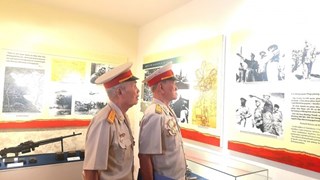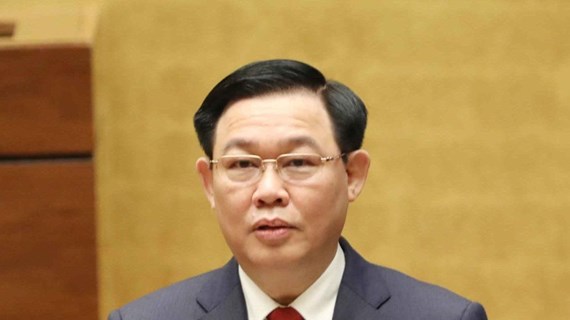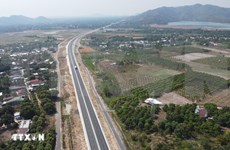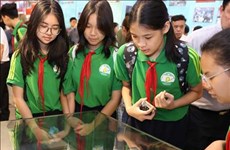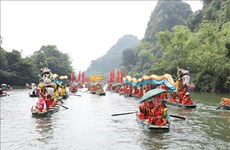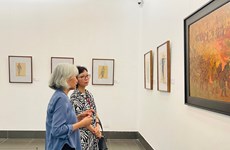Oc Eo civilisation - significant part of Vietnam's treasure
The Oc Eo civilisation contributes 10 sets of ancient objects to the
list of the 77 national treasures. Insight by the Government Portal.
The Oc Eo civilisation contributes 10 sets of ancient objects to the
list of the 77 national treasures. Insight by the Government Portal.
Oc Eo has been regarded as part of the historical kingdom of Funan that flourished in the Mekong delta provinces of An Giang, Kien Giang, Dong Thap and Bac Lieu and Can Tho city, and part of Cambodia between the 1st and the 6th century.
The objects found at the Oc Eo archaeological sites include pottery, tools, jewelry, casts for making jewelry, coins and religious statues. Among them are gold jewelry imitating coins from the Roman empire of the Antonine period.
Excavation at Oc Eo began on February 10, 1942 after French archaeologists had discovered the site through the use of aerial photography.
Archaeological sites reflecting the material culture of Oc Eo spread throughout southern Vietnam, densely concentrated in the area of the delta to the south and west of Ho Chi Minh City.
The most significant site, aside from Oc Eo itself, is at Thap Muoi, north of the Tien Giang River, where a stele with a 6th-century Sanskrit text has been discovered.
Among the previous 10 Oc Eo objects recognised as the national treasures, there are three Vishnu goddess statues. Vishnu is the supreme God of Vaishnavism, one of the three main sects of Hinduism, and described as the all-pervading essence of all beings, the master of - and beyond - the past, present and future, the creator and destroyer of all existences, one who supports, preserves, sustains and governs the universe and originates and develops all elements within.
The Loi My Buddha statue was found on April, 27, 1973 in Loi My village, Dong Thap province. The 100-kg statue, sculptured from a Trai trunk-tree, is considered a typical piece of Southeast Asia’s sculpture.
The God Surya statue was found in the summer in 1928 in Long Xuyen, An Giang province. The statue, said to be made around 1,500 years ago, has a height of 90 cm and a width of 38 cm and weighs 80 kg. Surya is the chief solar deity in Hinduism, the chief of the Navagraha, Indian "Classical planets" and important elements of the Hindu astrology.
The Binh Hoa Buddha statue and the Sa Dec Buddha statue are currently stored at the History Museum of Ho Chi Minh City.
Goddess Durga, which means "the inaccessible" or "the invincible", is the most popular incarnation of Devi and one of the main forms of the Goddess Shakti in the Hindu pantheon. The statue of this goddess is displayed also at the History Museum of Ho Chi Minh City.
The museum also houses a statue of Avalokitesvara, a bodhisattva who embodies the compassion of all Buddhas. Portrayed in different cultures as either male or female, Avalokitesvara is one of the more widely revered bodhisattvas in the mainstream Mahayana Buddhism, as well as unofficially in Theravada Buddhism.
The collection of golden artifacts, stored in the Museum of Long An province, manifests remarkable value as it proves the creativity of Oc Eo people. Golden lotuses in the collection are a piece of evidence of Buddha’s philosophy. Eight rectangle-shaped gold sheets are carved with the image of elephant with the length of 2.9-3.3 cm and the width of 2.6-3 cm.-VNA
Oc Eo has been regarded as part of the historical kingdom of Funan that flourished in the Mekong delta provinces of An Giang, Kien Giang, Dong Thap and Bac Lieu and Can Tho city, and part of Cambodia between the 1st and the 6th century.
The objects found at the Oc Eo archaeological sites include pottery, tools, jewelry, casts for making jewelry, coins and religious statues. Among them are gold jewelry imitating coins from the Roman empire of the Antonine period.
Excavation at Oc Eo began on February 10, 1942 after French archaeologists had discovered the site through the use of aerial photography.
Archaeological sites reflecting the material culture of Oc Eo spread throughout southern Vietnam, densely concentrated in the area of the delta to the south and west of Ho Chi Minh City.
The most significant site, aside from Oc Eo itself, is at Thap Muoi, north of the Tien Giang River, where a stele with a 6th-century Sanskrit text has been discovered.
Among the previous 10 Oc Eo objects recognised as the national treasures, there are three Vishnu goddess statues. Vishnu is the supreme God of Vaishnavism, one of the three main sects of Hinduism, and described as the all-pervading essence of all beings, the master of - and beyond - the past, present and future, the creator and destroyer of all existences, one who supports, preserves, sustains and governs the universe and originates and develops all elements within.
The Loi My Buddha statue was found on April, 27, 1973 in Loi My village, Dong Thap province. The 100-kg statue, sculptured from a Trai trunk-tree, is considered a typical piece of Southeast Asia’s sculpture.
The God Surya statue was found in the summer in 1928 in Long Xuyen, An Giang province. The statue, said to be made around 1,500 years ago, has a height of 90 cm and a width of 38 cm and weighs 80 kg. Surya is the chief solar deity in Hinduism, the chief of the Navagraha, Indian "Classical planets" and important elements of the Hindu astrology.
The Binh Hoa Buddha statue and the Sa Dec Buddha statue are currently stored at the History Museum of Ho Chi Minh City.
Goddess Durga, which means "the inaccessible" or "the invincible", is the most popular incarnation of Devi and one of the main forms of the Goddess Shakti in the Hindu pantheon. The statue of this goddess is displayed also at the History Museum of Ho Chi Minh City.
The museum also houses a statue of Avalokitesvara, a bodhisattva who embodies the compassion of all Buddhas. Portrayed in different cultures as either male or female, Avalokitesvara is one of the more widely revered bodhisattvas in the mainstream Mahayana Buddhism, as well as unofficially in Theravada Buddhism.
The collection of golden artifacts, stored in the Museum of Long An province, manifests remarkable value as it proves the creativity of Oc Eo people. Golden lotuses in the collection are a piece of evidence of Buddha’s philosophy. Eight rectangle-shaped gold sheets are carved with the image of elephant with the length of 2.9-3.3 cm and the width of 2.6-3 cm.-VNA
